Origin and History of Lake Grapevine, 1919-1953, Part 3: The Trinity River Project Goes To Washington
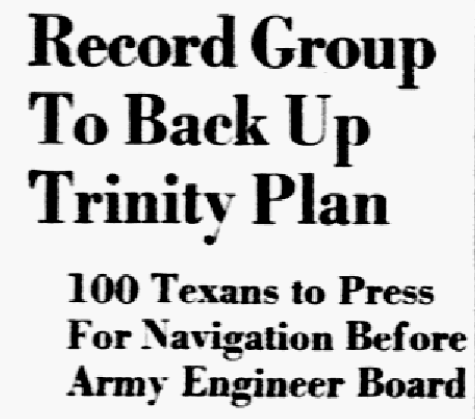
In 1940, the Trinity River watershed consisted of seven regions, six of which are shown on the map below (Fig. 1): West Cross Timbers, Grand Prairie, East Cross Timbers, Blackland Prairie, Coastal Flatwood, and Coast Prairie. Grapevine lay on the border between the East Cross Timbers and Blackland Prairie regions.
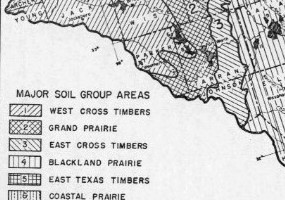
As mentioned in the previous blog, flooding had caused critical soil erosion and devastating crop damage to farms in the Trinity River basin. The formation of the Texas soil conservation boards in late 1939 was intended to achieve and maintain good soil conservation practices, among which was flood control. It also allowed farmers to apply for federal funds to assist them in these endeavors. Preliminary reports pertaining to the proposed Dalworth district, of which Grapevine Mayor B. R. Wall would be a supervisor, demonstrated that soil and economic conditions there were better than anticipated but still in need of attention.
Dalworth Soil Conservation District Formed
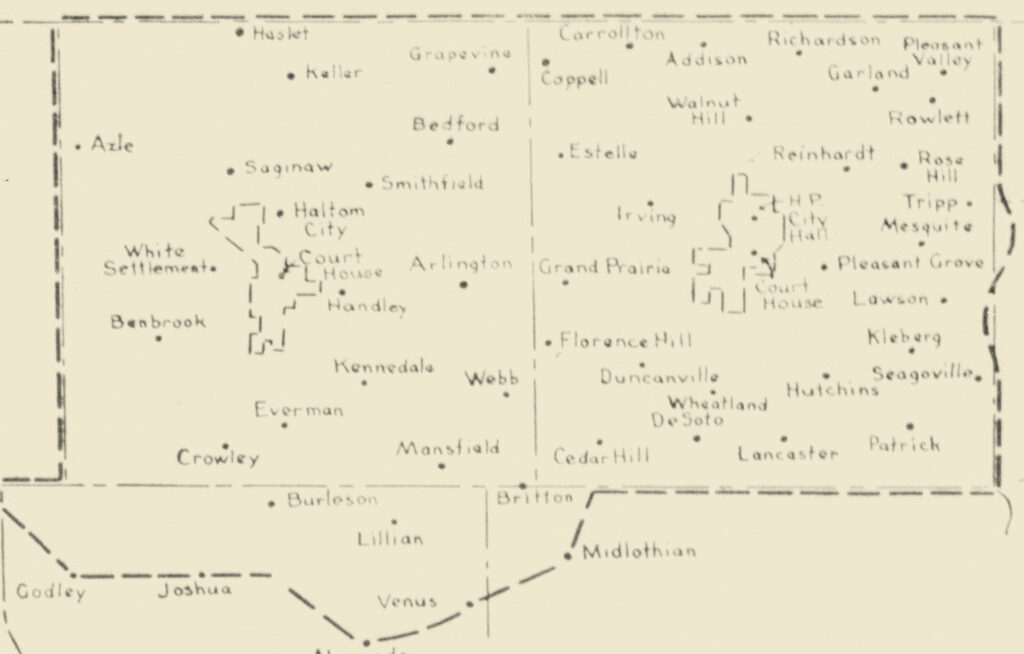
The Dalworth Soil Conservation District was voted into existence on May 25, 1940. All land, farm, and ranch owners, including wives, were eligible to cast ballots. Overall, voting in Tarrant County was light. Precinct 45 at Grapevine, which included the school districts of Grapevine, Minters Chapel, Pleasant Glade, Miller, and Carroll, voted in favor, with forty-eight for and twenty against. After the formation of the district, names were submitted to the State Soil Conservation Board for approval so they could stand for election as district supervisors. Grapevine Mayor B. R. Wall, the only one from Tarrant County, was one of them. Mayor Wall was an attorney by profession, but he was also a farmer, born and raised in Grapevine. In 1940 he had an interest in nine farms covering 950 acres in the vicinity of Grapevine He knew that erosion had been a major agricultural problem for several decades and had taken steps to prevent it on his properties. On August 31, 1940, he was elected as one of three members, receiving 331 votes, the highest number of any candidate. All three members were sworn in on September 20, 1940, and William E. Moncrief of Arlington was elected chairman. Applications to Dalworth supervisors for farming assistance began in late May 1941.
Dalworth Soil Conservation District contained about 1,303,000 acres of farm and ranch lands, nearly 200,000 acres of which are situated in the flood plains of the Trinity River and of the East, Elm, West, and Clear Forks of the Trinity tributaries. Flood plains of these streams made up one of the most serious problems of this district. Locally constructed levees often failed to hold up against heavy floodwaters, and various kinds of flood debris frequently choked the Trinity tributaries. This resulted in heavy property loss and sometimes loss of life. Dalworth members were asking to be given the same kind of federal assistance provided for residents in other watersheds.
Trinity River Project Heads East (and Some Dallasites Head “West”)
On June 13, 1941, several delegations with interests in the Trinity River basin project began traveling to Washington to attend a June 16 hearing before the Board of Engineers for Rivers and Harbors on the merits of the project. The Dalworth district was represented at the hearing by its chairman, William E. Moncrief, who was also president of the Tarrant County Farm Bureau. The supervisors had passed a resolution to the Board of Engineers, calling attention to protection and conservation programs, including levees, which district citizens carried out at their own expense. They listed the many benefits that landowners and other interests in the area would gain from the proposed flood control and canal programs and urged the Board to approve the Trinity project as submitted by the Army’s Southwestern engineer.
Agreement over the project, however, was not total. Although Mayor Wall strongly supported soil conservation, in his regular column in the June 19, 1941 issue of The Grapevine Sun, he expressed concern over the possible effects that construction of the Grapevine Reservoir would have on the city’s economy. “If,” he observed, “we are to have a big lake to the north of us on Denton Creek, we hope, perhaps against hope, that there will be plenty of bridges so that our trade territory will not be substantially reduced. Also we hope that we will have a few gravel pits left open for use.” It is interesting to note that on June 11, 1941, Mayor Wall noted the severe flooding of the Trinity during storms in late May 1941 (Figure 3) and compared it with the devastating flood of 1908 but did not mention the reservoir as a way to prevent this problem. In his diary, he wrote that “Denton Creek is out almost as bad as in 1908. Bus cannot get to Denton.” Similarly, on June 13, he wrote, “Denton Creek still out.” He simply singled out flood damage to the soil and observed that sufficient local interest in conservation was still lacking. “If you will drive around after a rain,” he said, “you will easily locate the crying necessity for immediate action.”
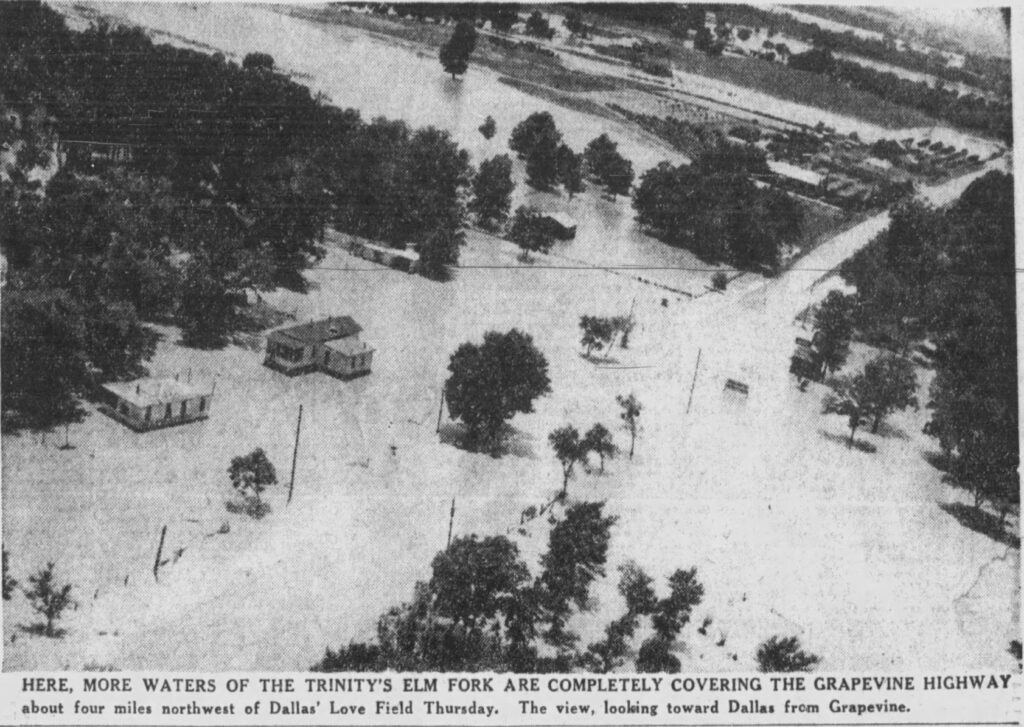
On June 16, 1941, over one hundred Texans, bolstered by the support of late Texas Senator Morris Sheppard, who favored the project, were present at the hearing in the auditorium at the Department of the Interior. They were hopeful, after a thirty-year fight, of getting congressional approval for the $118,000,000 Trinity navigation and flood control project. John M. Fouts, general manager of the Trinity Improvement Association (TIA), asserted to the Board that the best evidence of the feeling of the farmers in the area was the recent establishment of soil conservation districts in the Trinity basin. In every instance, at least eighty percent of farmers voted in favor of them. William E. Moncrief emphasized that “farmers in Texas believe the two programs working together will solve their transportation, erosion and flood control problems.”
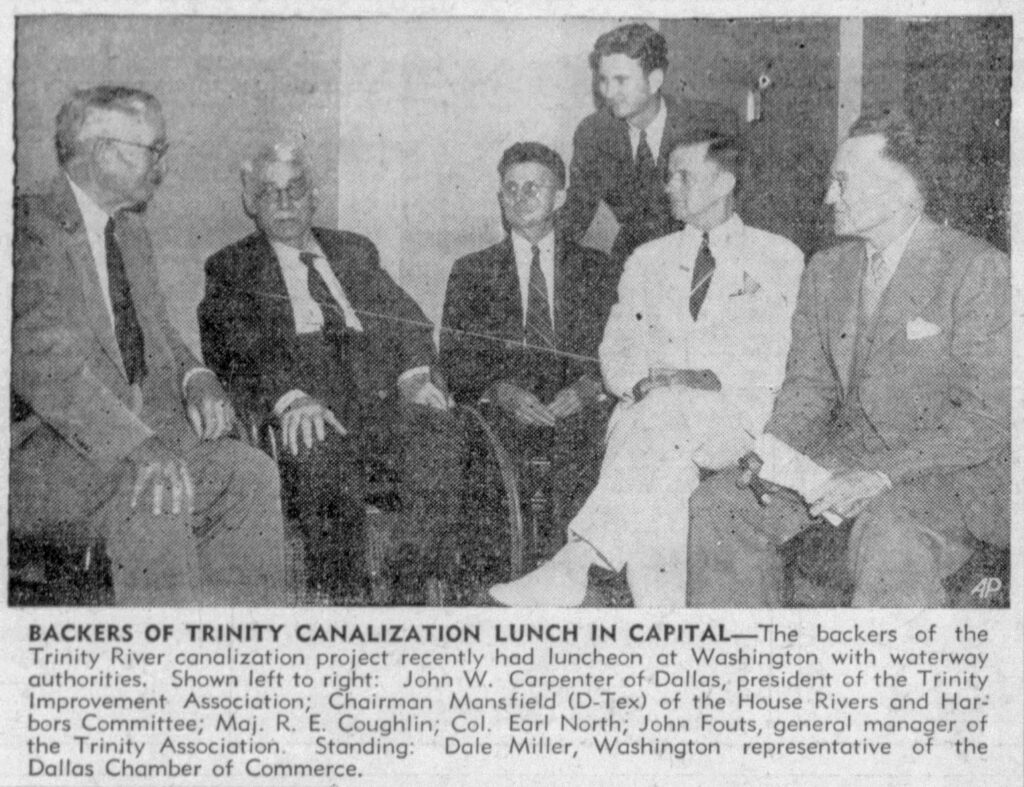
In a letter dated September 4, 1941 to Secretary of War Henry L. Stimson, Major General Julian. L. Schley, Chief of Engineers, US Army Corps of Engineers, stated that he endorsed and was enclosing the detailed engineering report of the 1939 Trinity watershed survey. Stimson submitted the report to the Speaker of the House on October 1, and on October 2 it was referred to the Committees on Rivers and Harbors and ordered to be printed. It became House Document No. 403, 77th Congress, 1st Session, “Trinity River and Tributaries, Texas.” Schley declared his support of a “comprehensive plan of improvement” of the Trinity River and its tributaries but concurred with the Board of Engineers for Rivers and Harbors that canalization of the Trinity to Fort Worth was not justified at that time. Instead, canal construction would be undertaken only from the Houston Ship Channel to Liberty. The Board recommended, among other things, the construction of Benbrook, Little Elm, and Grapevine Reservoirs for flood protection and water conservation.
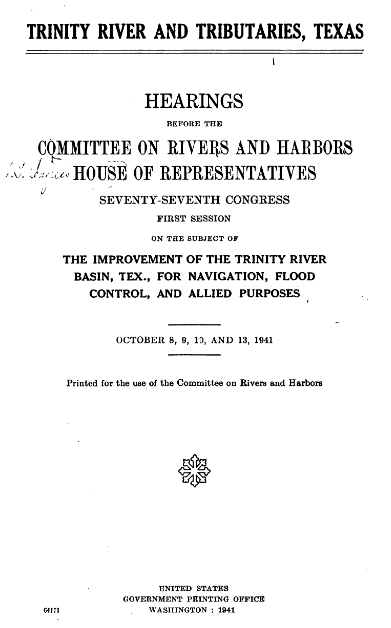
Hearings before the House Committee on Rivers and Harbors for the Trinity River and Tributaries, Texas commenced at 10:30 a.m. on October 8, 1941 (Fig. 4). Joseph J. Mansfield of Texas was the committee chairman. John Fouts of the TIA stressed the high level of interest in the project by stating that its purpose was to “develop an over-all program of soil and water conservation . . . so as to use the soil . . . and water for its maximum benefits.” He also called the committee’s attention to the fact that all federal projects for the Trinity watershed were turned down so a general comprehensive plan like the Trinity could be carried out unilaterally, therefore not wasting money on smaller piecemeal projects. Testimony from representatives of various localities within the watershed was given in favor of flood control, soil erosion, and canalization over a four-day period, including the Park Cities, who set their own plans for a dam aside and joined with Dallas to support the construction of the dam near Grapevine on Denton Creek. Opposition groups representing railroads and Oklahoma also presented their cases. The Committee on Rivers and Harbors reported favorably on the project, and it was placed on the House calendar; if approved, only part of it would be authorized for construction. The Texas delegation believed they had made a solid case but would have to wait a while for congressional response.
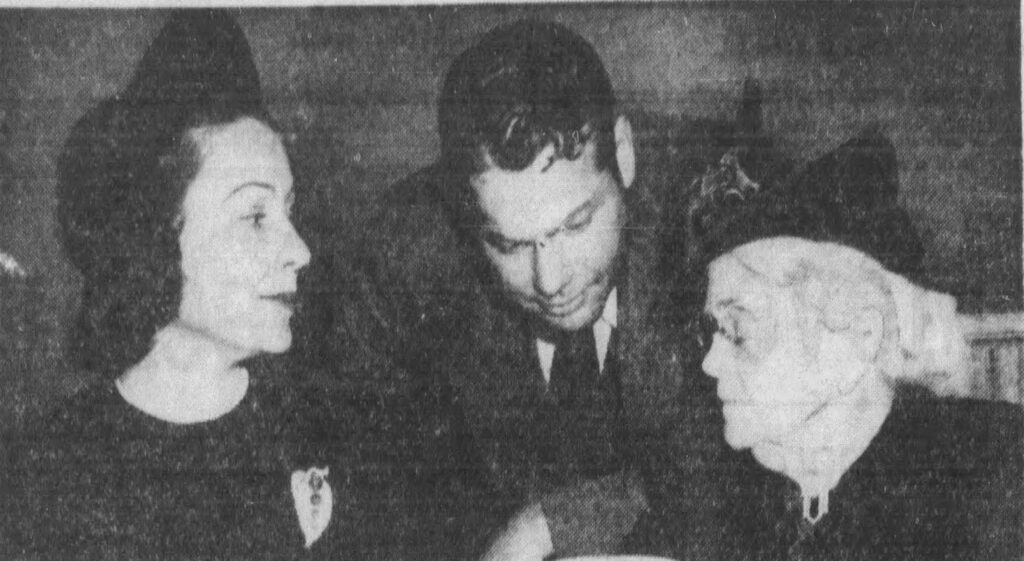
In the meantime, a back-to-the-land movement had taken root across the country, especially in the agricultural Southwest. Multiple surveys revealed several reasons for this, but the main reason was that investment was shifting to farms as a hedge against inflation. Others believed it was due to society’s recognition, believed lost during the rise of industrialization, that soil was a main source of life. Whatever the explanations, this movement was also realized in Grapevine. On November 26, 1941, the city, sponsored by the Grapevine Lions’ Club, honored and welcomed seventy urban families from Dallas and Fort Worth (mostly Dallas) who had bought farms within an eight-mile radius of Grapevine. Jokingly referred to as “city slickers,” some lived on their farms, while others commuted from them to work in their urban jobs as businessmen and teachers. Lions Club president W. F. Cannon noted that “in the country, they find refreshment and wholesome living,” as well as consumer goods from Grapevine businesses. Many of these landowners would be affected by the construction of a reservoir on Denton Creek.
The Trinity project gained significant strength in February 1942 when President Franklin D. Roosevelt urged passage of the bill to Rivers and Harbors Committee chairman Joseph J. Mansfield. Mansfield reiterated that only those projects deemed essential as defense by appropriate war agencies would be funded. Due to the war effort, the Trinity project was not among them; it would have to wait until six months after the war ended. However, in early June 1943, flood control features of the project were formally taken over by the House Flood Control Committee after consulting with the TIA and other directly affected entities. Those features were to be included in an omnibus bill the committee was drawing up for passage later in the year. Navigation features were left to the Rivers and Harbors committee, as flood control was seen as a more urgent matter.
On November 16, 1943, the House of Representatives approved the $15,000,000 request for Trinity River improvement as a post-war project. No appropriation of money would be requested until the following year. Construction of Benbrook, Little Elm, and Grapevine Dams, and modification of Garza Dam, was recommended. The cost for this work would be lessened by the Park Cities’ contribution of $607,000 in exchange for 50,000 acre-feet of water for their use in the Grapevine Dam. The reservoir would hold 54 billion gallons. The Senate passed the Rivers and Harbors Bill on December 12, 1944, and the flood control bill awaited Roosevelt’s signature. The soil conservation phase was already underway, with the soil conservation districts having been set up in ninety-two percent of the upper Trinity region. Everything would be ready for construction as soon as the war ended. John W. Carpenter, TIA president, praised all those who worked for the Trinity Project. “ . . . [P]assage of the rivers and harbors bill,” he declared, “is a milestone of great progress for this section of the country.”
In the next blog, we will see Grapevine get a lake and how Grapevine residents responded to a changed landscape along Denton Creek.



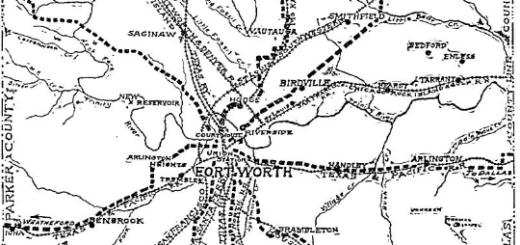

Recent Comments